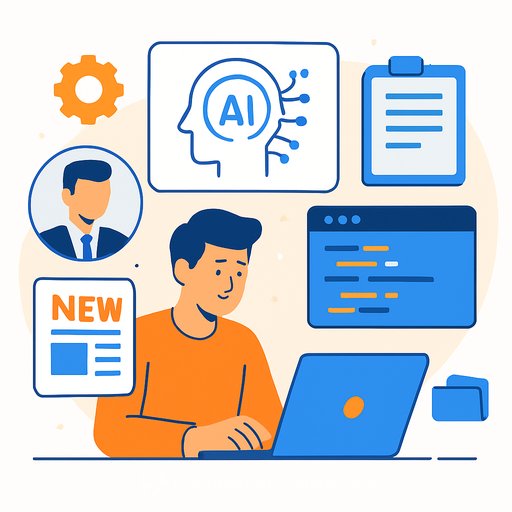Transatel's CEO on tripling product development with AI: how Ubigi builds an eSIM edge
Ubigi launched in 2017 as a full MVNO, not a reseller. That choice created an advantage product teams will recognize: direct control of the stack, from network access to UX. The payoff shows up in faster iteration, tighter integrations, and features competitors can't match easily.
Today, Ubigi delivers 5G in 60+ countries, multi-operator coverage for reliability, and OEM integrations that reduce friction. It's already embedded in iPad eSIM settings, and the team is working to make smartphone activation seamless, eliminating QR codes.
Own the critical path: full-stack control fuels faster product cycles
As a full MVNO, Ubigi controls the user journey end to end. The app lets users top up without remaining data or Wi-Fi. That single decision compounds into speed: fewer dependencies, more surface area to test and ship, and the ability to coordinate with device makers directly.
Partnerships with Apple and automakers like MINI, Stellantis, BMW, and Toyota extend reach across phones, tablets, laptops, and connected cars-managed under one account.
Control latency with local packet gateways
Ubigi is rolling out packet gateways (P-GWs) in multiple regions. Routing traffic closer to where users are cuts latency and stabilizes performance for video calls, streaming, and gaming. Multi-operator agreements keep sessions on the best available networks per country, with 5G where offered.
This is a playbook any product team can borrow: go local to reduce wait time, expose network choices transparently, and back it with formal service agreements for faster problem resolution.
Security as a feature, not an add-on
Ubigi launched a feature that lets users select and switch IP locations-destination or home-without installing a separate VPN. It's a small interaction with big impact for access, privacy preferences, and content that depends on location.
Security features that remove extra apps, sign-ups, or steps create trust and lower churn. Treat them like core UX, not afterthoughts.
AI as a throughput multiplier for product development
Transatel CEO Jacques Bonifay sets a clear target: triple product development velocity within a year, and reach a 10x acceleration within two. The path runs through AI embedded across the lifecycle.
- Prototyping: turn early designs into interactive tests for stakeholders.
- Build: automate repetitive tasks; generate scaffolds and features from specs.
- Engineering aid: library selection, code optimization, translations, and chatbots.
- Quality: expand automated testing and log analysis to cut QA effort while raising coverage.
The mindset shift matters: engineers won't just use AI to support production; they'll guide AI to produce. That means knowing when to avoid it, validating outputs, and keeping humans in the loop for design and risk.
Scaling support without scaling headcount
Ubigi launched an AI chatbot at the end of 2024. It resolves over half of incoming requests, effectively doubling support capacity. Next steps include broader self-service coverage and an assistant that recommends the right data plan during checkout.
For product ops, this is a blueprint: target high-volume intents, measure deflection and CSAT, then expand coverage. Keep escalation fast for edge cases.
Observed usage shifts product teams should note
- Multi-device is the norm: phones, laptops, and cars under one account.
- Heavier data consumption: more users move to unlimited plans.
- Network outages drive spikes: users lean on multi-operator access as a safety net.
Ubigi now covers 200+ destinations through carrier relationships built over two decades via Transatel and the NTT Group. Work is underway where regulation or infrastructure is tougher; the stance is to be transparent about limits while expanding footprint.
What product leaders can apply this quarter
- Own key dependencies: reduce third-party blockers on core flows (activation, billing, identity, support).
- Localize performance: place compute/gateways closer to users; log and publish latency by region.
- Ship security into the main flow: build features like IP controls, fraud checks, and privacy defaults into the primary UX.
- Make coverage and quality visible: show network options and expected performance pre-purchase.
- Institutionalize AI: define a model for prompts, validation, test generation, log triage, and code review with guardrails.
- Measure throughput, not activity: track time-to-prototype, cycle time, change failure rate, test coverage, and support deflection.
- Design for multi-device accounts: single login, shared balance, simple eSIM management across hardware types.
Key metrics to track
- Product velocity: cycle time per feature; % of tasks assisted by AI.
- Quality: automated test coverage; defects per release; time to detect via log analysis.
- Performance: median latency per region; % traffic routed via local gateways.
- Support: chatbot resolution rate; first-contact resolution; time to human escalation.
- Reliability: multi-operator availability; 5G reach by market; outage fallback success rate.
What's next for Ubigi
Deeper OEM integrations to remove activation steps on smartphones. Wider rollout of IP location switching. More packet gateways for lower latency at scale. Exploration of eSIM and satellite convergence, supported by NTT Group capabilities.
Learn more
Level up your team's AI workflow
If you're building an AI-first product pipeline like Ubigi's, curated learning by role can speed up adoption and consistency across squads. Explore practical options here: AI courses by job.
Your membership also unlocks:






